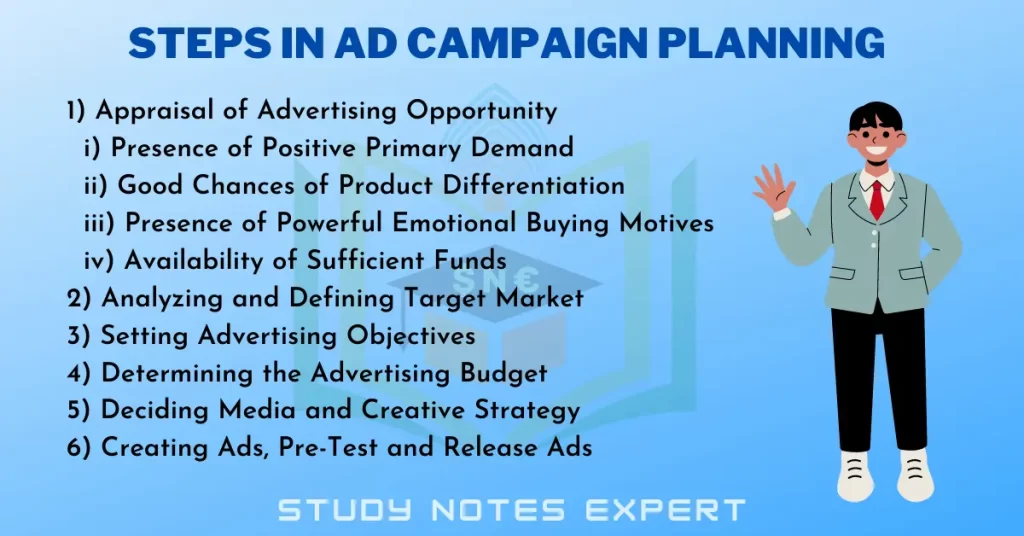An advertising marketing campaign is an organized collection of commercial messages with a specific idea and subject matter to sell a product or service. It can broadcast through numerous media channels such as TV, radio, net, etc. In a broader view, a campaign is a systematic route of action. This is mainly designed to attain hard and fast objectives and to solve certain problems in a specific timeframe, i.e., 12 months or much less. In the next section, you will know the steps in ad campaign planning.
According to Dunn and Barban, “An advertising and marketing marketing campaign includes a series of ads, placed in various media, which can be designed to satisfy targets, and are primarily based on analysis of advertising and conversation situations.”
Planning of advertising marketing campaigns is an extended technique and could be very significant for the successful execution of the employee marketing campaign.
Steps in Ad Campaign Planning

The advertising organization has to conduct an intensive study at some stage in the planning manner and then finalize elements of the advert marketing campaign. Generally, the making plans method of an ad campaign includes the following steps:
1) Appraisal of Advertising Opportunity
A marketer can adopt something other than advertising as their promotional tool. A marketer ought to determine whether marketing is suitable for its advertising and marketing method or now not. It is an important steps in ad campaign planning.
According to Neil H. Borden, 5 conditions govern the marketing possibility:
i) Presence of Positive Primary Demand
When there may be high demand for a particular product, the chances of the advertiser’s success are higher. This is much more likely to occur while a product is on the growing degree of its life cycle.
ii) Good Chances of Product Differentiation
Purchasers can regard Numerous products as alternative merchandise. They require no or less marketing.
iii) Presence of Powerful Emotional Buying Motives
If a product well-known shows a strong emotional shopping for a reason or if the purchasers are emotionally attached to the product, then the want for advertising and marketing no longer exists.
iv) Availability of Sufficient Funds
If more finances are needed to set up an advertising budget, then much less recognition should be received on ad campaigns.
Hence, the first situation relates to the character of the marketplace, remaining situations relate to the consumer’s perceptions and the products themselves. Effective advertising and marketing help the organization attain its advertising goals if the above conditions are a gift. Conversely, if these conditions are absent, advertising and marketing have made a negligible contribution.
2) Analyzing and Defining Target Market
Market analysis for specific products has distinctive consequences. For hooked-up products, marketplace analysis will offer past facts of what has been done formerly. While in the case of a brand-new product, in-intensity research requires discovering new insights. The primary consideration necessary for precise advertising and marketing is clearly understanding advertising targets, which can be based totally on the unique marketplace analysis. The primary goal of the advertising is to reply to two primary questions, i.e., wherein are we nowadays? And how did we get here? It shows the steps in ad campaign planning. A proper advertising-making plan gives all the facts associated with the specific product, including brand percentage, market conditions, competitors’ percentage, and criminal/ political constraints.
3) Setting Advertising Objectives
The promotion or emblem manager must determine specific targets for an advertising and marketing campaign and every commercial with their opted medium. While setting the targets of the ad campaigns, managers normally use the ‘hierarchy of outcomes model.’ By using this version, all the elements of the marketing campaign aid every other, which may create a high-quality response from the target audience. This direction leads the advertisers from the conversation objectives to income objectives, referred to as ‘awareness advertising to direct-movement advertising’. It is the steps in ad campaign planning.
4) Determining the Advertising Budget
Advertising goals outline the milestones to carry out an ad campaign at a specific time. A finances units a limit and controls all proposed prices related to the advert campaign. Several procedures help determine the ad budget and exclusive groups undertake exclusive techniques for correct allocation in their ad price range. It is an essential decision-making technique because it entails a large sum of money, and it’s far more difficult for the advertiser to analyze the marketplace situations so one can produce beneficial effects. Generally, full control has a great subject for the accountability of marketing finances. It is one of the important steps in ad campaign planning.
5) Deciding Media and Creative Strategy
The marketing techniques contain important decisions associated with media choice and the advent of advertisements. The media plan and the innovative plan develop simultaneously. The merchandising manager generally decides the media, after which he establishes the ad design. Media planning is a complicated process as different media have unique characteristics. A Media plan offers a pleasant way to attain the target audiences with the ad message. It is one of the steps in ad campaign planning. Here, the principal intention of the advertiser is to intentionally choose suitable quality media to reach a massive audience at the lowest possible value.
6) Creating Ads, Pre-Test and Release Ads
Pre-checking out of the advert marketing campaign is critical earlier than introducing it into the market. Some reasons for pre-checking out include growing media expenses, competitors’ ad target market apathy and dislikes of ads, etc. Therefore, it’s essential for organizations to make sure that the target audience understands the marketing campaign message. It is one of the important steps in ad campaign planning.

